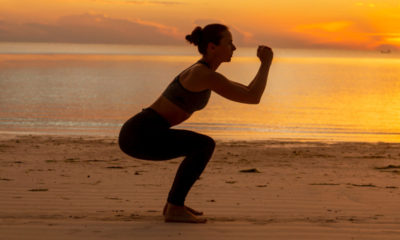Fitness
Running Your Numbers
Running can be a very divisive topic. You either believe it’s the ultimate elixir for pretty much everything that’s wrong in your existence. Or it can be little more than auto critique of your movement patterns where you’re rewarded with a rolled ankle topped with a lower back strain. Despite these opposing narratives, one of the very first things you learn, long before you even consider groaning about your baby fat, is how to run. Running is hardwired into your DNA because your physiology actually supports long distance marathons, found a study in the journal Nature. These lab coats wearers discovered endurance running was so fundamental to human survival that it shaped the mechanics of your entire physique. So, if you think that your body shape doesn’t conform to Lulumon leggings then that means it was excused from evolution, then you need to hit the back-space button on your perceptions because you were literally born to run. The challenging part about running is making sense of all the misinformation surrounding it. Ready to find the truth? On your marks, get set – go.
The Toll On Your Body
Lacing up your training is most women’s Pavlovian response to the first hint of an unflattering photo on your friend’s social media feed. And there’s no disputing that regular sweat sessions are essential for maxing out the candles on your birthday cakes. However, you can have too much of a good thing because there’s a delicate balance between activity and lethargy that optimizes health and longevity. A study in the Journal of Obesity kept tabs on 12,951 distance runners for 9 years and found the majority gained body fat and increased their waist circumference, even if they never quit running. Huh? Turns out, those who gained the most fat decreased their distance, mainly due to running injuries, but even those who maintained their mileage, got fatter. Only runners, who significantly increased their mileage, by three-fold, didn’t add weight. Take home message: unless you get to near-marathoner level, running makes you fatter in the long term if you’re eating and the training the same because your metabolism slows as you age. The isn’t the rusty nail in running’s coffin, instead it’s a chance to make sure you moderate both diet and mileage as you age because runners often believe they can scoff whatever they want if they’re getting daily thumbs-ups from their fitness trackers. The answer? Simple moderation. A new paper in Progressive Cardiovascular Diseases looked at running’s effect on your longevity and found doing it for just a couple hours each week added 3.2 years to your life. Hold up, additional miles don’t mean a longer life because the benefits plateaued at fours of running a week. That means 2-3 runs lasting 30-40 minutes each week is the goldilocks zone because even hour spent running adds 7 hours to your life. That’s a very worthy kick back for just a smidgen of effort. However, even if you can only manage a few runs, there are still benefits to be enjoyed because a paper in the British Journal of Sports Medicine found that just about any amount of running associated with a 27% lower risk of death from all causes for both genders. So even small doses, like running once a week or less, when they last less then 50 minutes a time at a very slow speed, will still prop up your longevity. This was an observational study, so the egg heads actually don’t know why, but you (and billions of others) probably don’t know why electricity turns on the TV either, yet you still tune in. So, don’t over think the physics of it too much, rather get busy with the actual business of getting from A to B.
Run With Less Pain More Gain
How you can keep making progress by employing these sneak-attacks into your running repertoire
- Store Your Momentum
Unless your doc or physio explicitly tells you to hang up your poly-shorts, keep at it. New research at Brigham Young University found running actually pounds knee inflammation into the ground. The runners only ran for 30 minutes at a time so don’t think more miles will strong arm your creaky knees into better health, but it is proof that an active recovery is the worth the effort.
- Auto-Tune Your Recovery
Jax Jones might get you G’d-up-from-the-feet-up, but your ability to recover between efforts is what creates consistent results, and this starts with dope music selections during your recovery stints when you’re running intervals. A paper in the Journal of Strength and Conditioning Research found when people exercised at their maximum intensity then listened to music set to a leisurely 140 beats per minute, saw their blood lactate levels dropped faster thanks to the music. In short: they recovered faster. So, if you’re running intervals, flick to more chilled tracks during your recovery and you’ll hit the next sprint at a higher intensity.
- Don’t Get Sold
Overprice running kicks are not always an indicator of quality, regardless of how sexy that new bubble gum colored kicks might be. Overly cushioned shoes caused more damage to knees, hips and ankles than barefoot running, found a study in PM&R: The journal of injury, function and rehabilitation. Take comfort in the notion that we haven’t evolved to need Day-Glo cushions to illuminate our every step. That’s said, barefoot running isn’t an injury elixir and can cause problems if you dive in with reckless abandon because you’ll probably lack the foot strength. Rather ease yourself into it by barefoot running over 10% of your usual weekly running load. Gradually increase this, especially if you have recurring injuries. Start on grass and sand, wearing barefoot running shoes to insulate your trotters against any sharp objects and add some fun to your nudie run.
Run Haters
You don’t need to run to enjoy the benefits because these are some very worthy alternatives to pavement pounding
- Elliptical trainer
Despite being super low impact, doing a cardio session on this machine place the same demands on your cardiovascular system, found a paper in the Journal of Sports Medicine and Physical Fitness. Pity the only scenery you can enjoy is from the gym’s plasma.
- Swimming
Despite placing pretty much zero impact on your joints, swimming will see an 180lb person burn 266, while they’d fry off 355 during running, a very worthy substitute.
- Rowing
Since your strapped in this full body workout has limited impact on your body but burns 377 calories if done vigorously by an 180lb person. You’ll also work your back muscle, giving yourself a V-shaped torso.
Put the fun in run
Many start, but few finish. Try these motivation tricks to keep going
- Schedule a regular running slot in your week. If you try to squeeze running into an overloaded diary it just becomes another stress.
- Find nice places to run. Two runs a week might have to be ’round the block’ but a weekend run somewhere different will lure you back.
- Set short-term goals. Aim first just to complete a distance – two miles, 5K or 10K – regardless of the speed. Once you reach the distance improve on your time.
- Add variety to your training to stop yourself becoming a one-pace runner. Vary the surface you run, the speed, distance and you can work out countless training sessions.
- Compete against others or the clock as it’s what makes the sport interesting. Get involved with a local club and look around for interesting races.
Best strength move for running: Pistol squat
- A) Stand with your feet shoulder-width apart. Raise your left leg off the ground so its knee is straight and in-line with the base of your abs, toes facing the ceiling.
- B) Bend your right knee to lower yourself until the bottom of your thigh is parallel to the ground. Straighten your knee to press yourself back to the start. Do 4 sets of 4-6 reps.
Why: Your gluteus medius are your lower core muscles that surround the outer part of the hip socket. They can become weakened from inactivity or prolonged sitting. It is important to strengthen them for lower core stability and leg alignment, especially for running sports like soccer, lacrosse, and running in general.
The Starting Blocks
This plan will take you from loafing to running continuously for 20 minutes in eight weeks using just three running sessions a week
Week 1: Run 1 minute, walk 90 seconds. Repeat 8 times. Do 3 times a week.
Week 2: Run 2 minutes, walk 1 minute. Repeat 7 times. Do 3 times a week.
Week 3: Run 3 minutes, walk 1 minute. Repeat 6 times. Do 3 times a week.
Week 4: Run 5 minutes, walk 2 minutes. Repeat 4 times. Do 3 times a week.
Week 5: Run 8 minutes, walk 2 minutes. Repeat 3 times. Do 3 times a week.
Week 6: Run 10 minutes, walk 1-2 minutes. Repeat twice. Do 3 times a week.
Week 7: Run 12 minutes, walk 1-2 minute. Repeat twice. Do 3 times a week.
Week 8: Run 20 minutes continuously.
After each session walk for five minutes to cool down and stretch gently for another five minutes. Don’t worry about speed or distance, clocking time on your feet should be your only concern.














